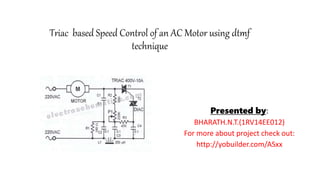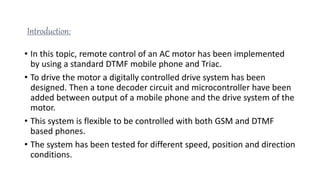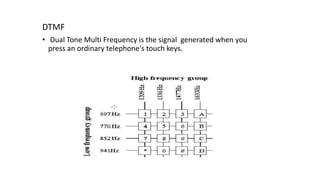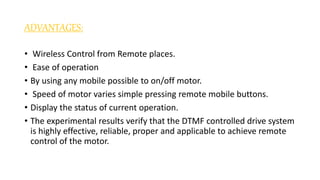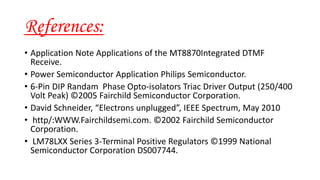Triac based Speed control of an ac motor using DTMF technique
- 1. Triac based Speed Control of an AC Motor using dtmf technique Presented by: BHARATH.N.T.(1RV14EE012) For more about project check out: http://yobuilder.com/ASxx
- 2. CONTENTS: • Introduction • Block diagram • DTMF decoder • Control and power circuit. • Advantages and disadvantages. • Conclusion.
- 3. Introduction: • In this topic, remote control of an AC motor has been implemented by using a standard DTMF mobile phone and Triac. • To drive the motor a digitally controlled drive system has been designed. Then a tone decoder circuit and microcontroller have been added between output of a mobile phone and the drive system of the motor. • This system is flexible to be controlled with both GSM and DTMF based phones. • The system has been tested for different speed, position and direction conditions.
- 5. HT9170 DECODER: FEATURES • Operating voltage-2.5~5.5V • 18 pin DIP package • Low standby current • Minimal external component • 3.58MHz crystal or ceramic resonator • No external filter is required.
- 6. DTMF • Dual Tone Multi Frequency is the signal generated when you press an ordinary telephone's touch keys.
- 7. DUAL TONE FREQUENCIES FOR CORRESPNDING KEYS:
- 8. • If press 1 then motor will TURN ON with Low speed. • If press 2then motor will TURN ON with MID speed. • If press 3then motor will TURN ON with HIGH speed. • If press 5then motor will TURN OFF Motor. Mobile button 1 - Data Out from 0001h Mobile button 2 - Data Out from 0010h Mobile button 3 - Data Out from 0011h Mobile button 5 - Data Out from 0101h
- 10. ADVANTAGES: • Wireless Control from Remote places. • Ease of operation • By using any mobile possible to on/off motor. • Speed of motor varies simple pressing remote mobile buttons. • Display the status of current operation. • The experimental results verify that the DTMF controlled drive system is highly effective, reliable, proper and applicable to achieve remote control of the motor.
- 11. DISADVANTAGES: • If receiver mobile range not available then does not possible to communication between them.
- 12. References: • Application Note Applications of the MT8870Integrated DTMF Receive. • Power Semiconductor Application Philips Semiconductor. • 6-Pin DIP Randam Phase Opto-isolators Triac Driver Output (250/400 Volt Peak) ©2005 Fairchild Semiconductor Corporation. • David Schneider, “Electrons unplugged”, IEEE Spectrum, May 2010 • http/:WWW.Fairchildsemi.com. ©2002 Fairchild Semiconductor Corporation. • LM78LXX Series 3-Terminal Positive Regulators ©1999 National Semiconductor Corporation DS007744.

